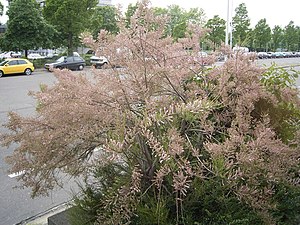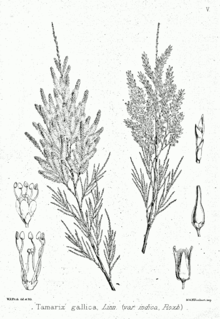French tamarisk
| French tamarisk | ||||||||||||
|---|---|---|---|---|---|---|---|---|---|---|---|---|

French tamarisk ( Tamarix gallica ) |
||||||||||||
| Systematics | ||||||||||||
|
||||||||||||
| Scientific name | ||||||||||||
| Tamarix gallica | ||||||||||||
| L. |
The French tamarisk ( Tamarix gallica ) is a species of the tamarisk ( Tamarix ) in the family of the tamarisk plants (Tamaricaceae).
description
Vegetative characteristics
The French tamarisk is a more or less papilose , evergreen shrub or tree and reaches heights of 2 to 4, rarely up to 10 meters. The trunk is upright and strongly branched, its bark is dark brown to purple in color. The branches are rod-shaped, arched and richly ramified. The twigs are finely striped and protruding upright to diagonally.
The leaves are in the shape of scales and are tightly screwed together. On young branches they overlap like roof tiles. They measure 1 to 3 × 0.5 to 1 millimeter and are usually close-fitting, sitting, simple and narrow-egg-shaped to lanceolate, with a pointed upper end. They are slightly keeled, at the base they are sharp to encompassing the stem, glabrous, gray to blue-green in color and have a membranous edge and numerous glands that are deepened in the shape of craters. They are often planted as shelter from the wind.
Generative characteristics
The flowering period extends from June to August. The short-stalked flowers sit individually in the armpits of long, pointed, narrow-egg-shaped bracts on annual twigs and form dense, 1 to 4 centimeters long, spiked, racemose partial inflorescences, together often panicle-shaped entire inflorescences. The hermaphrodite flowers are five-fold, pink to white and have a diameter of 2 to 3 millimeters. The sepals are pointed at the upper end, ovate to lanceolate and 0.5 to 1.3 millimeters long. The five petals are round, obovate, 2 to 3.5 millimeters long and sloping at the top. The stamens are fused at the base, have pink anthers and are almost the same length as the crown.
The capsule fruit, which is light pink when ripe, has a length of 3 to 4 millimeters, is narrowly conical, three-lobed and contains several seeds. The seeds have a long, feathery head of hair and are spread by the wind.
The number of chromosomes is 2n = 24.
Occurrence
The French tamarisk occurs in the western Mediterranean and from northwestern France to Sicily , in the east the distribution area extends to the territory of the former Yugoslavia . The French tamarisk grows on coasts, river banks and stony slopes from the plains to the hill country. It thrives best on moist, salty or gypsum-rich soils in sunny locations. Originally it occurs in Spain, France and Italy. It is naturalized in the United Kingdom, the Netherlands, and the United States.
literature
- Markus Bollinger, Matthias Erben, Jürke Grau, Günther Heubl: Shrub trees (Steinbach's natural guide). Mosaik Verlag GmbH, Munich 1996, ISBN 3-576-10560-3 .
Individual evidence
- ^ Erich Oberdorfer : Plant-sociological excursion flora for Germany and neighboring areas. 8th edition. Verlag Eugen Ulmer, Stuttgart 2001, ISBN 3-8001-3131-5 , p. 667.
- ↑ a b Tamarix in Germplasm Resources Information Network (GRIN) USDA , ARS , National Genetic Resources Program. National Germplasm Resources Laboratory, Beltsville, Maryland. Retrieved August 4, 2017.
Web links
- Tamarix gallica L., French tamarisk. In: FloraWeb.de.
- Profile and distribution map for Bavaria . In: Botanical Information Hub of Bavaria .
- Distribution in the Netherlands
- Thomas Meyer: Data sheet with identification key and photos at Flora-de: Flora von Deutschland (old name of the website: Flowers in Swabia )

